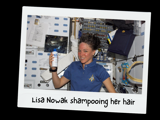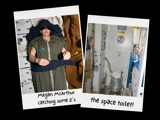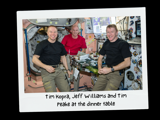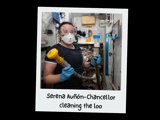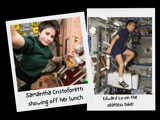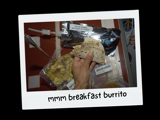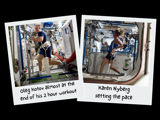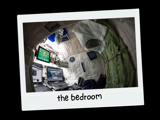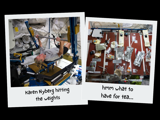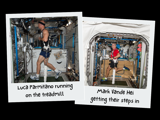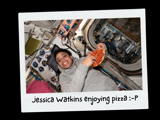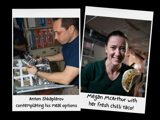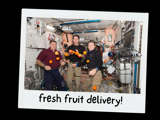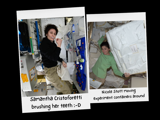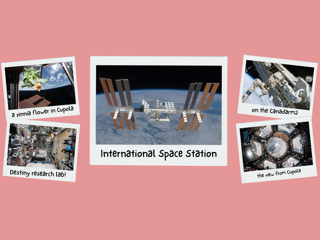
A Week in the Life of an Astronaut
- 3rd Oct 2025
- Author: Chloe Hopkinson
Okay, I would say “close your eyes and imagine…”, but then you won’t be able to continue reading, so I want you to imagine you are an astronaut. You have just woken up on a Monday morning aboard the International Space Station (ISS) and you feel your body floating and weightless inside your sleeping bag. You browse the schedule for the upcoming week and see your itinerary is jam packed with conducting research, performing science experiments, venturing out on a spacewalk and live calling a school down on Earth.
It’s going to be a busy week for you! But you’ve got this; you’ve already spent five months in space, with just one more to go.
You can handle anything.
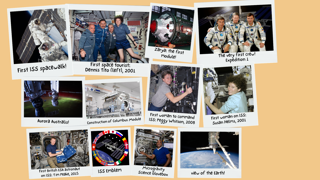
Days of the Week
Click the links to jump to the day of the week!
Monday: Earth Observation
Tuesday: Food Crops
Wednesday: Spacewalk!
Thursday: Fundamental Research
Friday: Live Conference
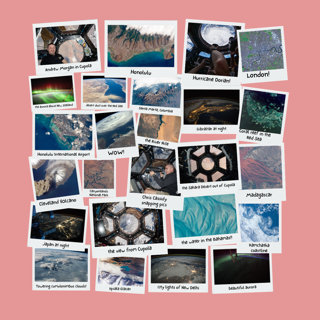
Monday: Earth Observation
After your wake-up routine you’ve been assigned to Earth observation duties. Gazing down at Earth from space feels like seeing a shiny jewel floating in the vast and silent universe. From the Cupola window of the ISS, the planet stretches out in a glowing curve – a unique vantage point to snap photographs of the Earth and its wonders. From the deep blues of oceans to the swirling white clouds, the golden orange deserts to the lush green forests, the bright lightning bolts to the dancing shimmers of the aurora borealis – Earth is alive, fragile, and breath-taking as it glimmers softly against the darkness of space.
As the ISS travels around the Earth roughly every 90 minutes on an inclined orbit, it eventually covers over 90% of the inhabited surface of the Earth and presents a unique perspective that simply cannot be obtained from the ground. Looking out of the Cupola window does more than provide an opportunity to capture images of our home: the photographs you take can help track the evolution of our planet. The images support research on our atmosphere, climate change, along with the monitoring of and response to natural disasters including flooding and volcanic eruptions, and more.
With the ISS experiencing 16 sunsets and 16 sunrises every day, night-time imaging of Earth can be used to check if power has been restored to cities after disasters, as well as tracking light pollution to conduct studies of urbanisation.
Daytime monitoring meant that astronaut Jeff Williams was the first person to witness the ash plume from a volcanic eruption of the Cleveland Volcano in Alaska back in 2006 and his observations and imaging of the event allowed him to alert the Alaska Volcano Observatory.
Observing and imaging Earth from space enables scientists and researchers to better comprehend and monitor changes on our planet, and this data allows for more informed responses to natural disasters from an angle you cannot get on Earth.
You wrap up your day with an intense two-hour workout on the bungee treadmill and weight set. This daily ritual keeps your bones strong, your muscles powerful, and your whole body unstoppable in microgravity!
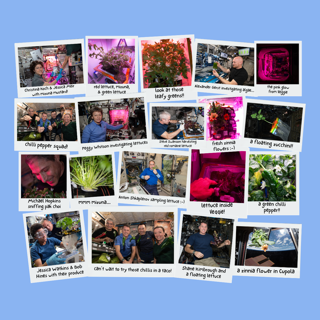
Tuesday: Food Crops
Tuesday’s tasks see you putting your green thumb to the test by tending to the Vegetable Production System, known as Veggie. As humanity plans to explore further from Earth to places like the Moon and Mars, the ability to grow food on board is a key factor in figuring out how to feed crews of astronauts for the weeks, months, and even years they will spend in space. The nutrition that fresh food brings is crucial to an astronaut’s diet to keep their meals well balanced with the vitamins and nutrients they require, whilst providing more exciting flavours and tastes.
Veggie has successfully grown a variety of plants and crops including lettuce, cabbage, peppers, chilli, kale, and pak choi. Astronaut Megan McArthur created space tacos in 2021 using fajita beef, rehydrated tomatoes and artichokes, and could add some much-needed spiciness using the space-grown chilli peppers.
Growing food crops in orbit is imperative to test equipment for long duration missions. You can perform plant transplants and sample the produce to fine tune the best techniques for future missions to come. The challenges you will face range from watering schedules to ensuring adequate lighting and providing enough space for roots to grow and spread in microgravity. The task is tricky but the drive to nurture, garden, and taste the produce motivates you and boosts the morale of you and your team.
After a day of staring at food, your stomach is grumbling for dinner. Sure, tonight’s menu doesn’t come that fresh - it’s dried, canned, vacuum-sealed, or freeze-dried. On the bright side, you've chosen your meals pre-mission from over 300 different items, including pizza, chicken curry, burritos, noodles, risotto, soup, and beef bourguignon. And tonight’s champion? A steaming, cheesy pouch of rehydrated mac and cheese. Bon appétit!
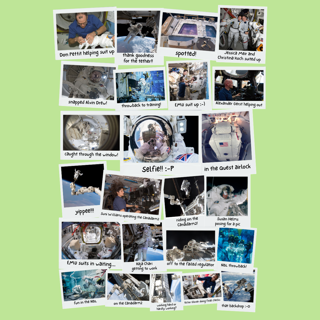
Wednesday: Spacewalk!
Wednesday rolls around and today is the day of your scheduled spacewalk, or Extravehicular Activity (EVA). This EVA was added to the itinerary for the week after an inspection saw that a power regulator had failed. You and a fellow crew mate will be suiting up and venturing out to complete the task in the vacuum of the universe – exciting but terrifying and your first-ever spacewalk! But you’ve prepared for this moment back down on Earth, where part of your astronaut training involved spending time in the Neutral Buoyancy Laboratory (NBL), which is essentially a huge swimming pool with submerged equipment and full scale mock ups of the ISS modules. You’ve donned the spacesuit before and dived into the NBL to practice with equipment and the breathing apparatus in simulated weightlessness. This can’t be much different, right?
You're feeling a bit jumpy though, so you're off for a quick nervous wee! The space toilet isn't your average bathroom break - it uses air to keep you in place whilst your urine gets siphoned away to be recycled into tomorrow's drinking water - cheers! Poo on the other hand, takes a one-way trip. It's stored in a tank and loaded onto an old cargo spacecraft where it eventually blazes through Earth's atmosphere in a flaming finale. For your EVA, you'll be sporting a Maximum Absorbency Garment, or for the non-astronauts in the room, a high-tech, astronaut-sized nappy!
The Extravehicular Mobility Unit (EMU) spacesuit takes hours to don (get into) and requires extensive checks before leaving the Quest airlock. Built to protect you against extreme temperatures, radiation, and the vacuum of space, it supplies oxygen, water, and mobility for up to eight hours.
The airlock opens and you use the handrails to pull yourself along to the outside of the space station. Floating in the vast silence of space, Earth comes into view – a radiant marble of swirling blues, greens, and whites, an instant reminder of how delicate our planet is. You keep venturing forwards and you feel your tether, that lifeline, attached from your suit to the station. With the replacement Sequential Shunt Unit, the size of a suitcase clutched in your gloved hand, you head towards Canadarm2, a robotic arm that lends a helping hand in ISS maintenance and moving astronauts around the space station. Locking your boots into place, a crewmate inside operates the arm, swinging you toward the faulty power regulator.
The repair is simple: swap the defective unit for the new one, restoring the station’s solar arrays to full function. With your main task complete, you get to work for a few hours on other minor duties including removing debris and solar panel inspections.
The team inside the ISS announce that it is time to head back to the airlock. You reunite with the crew and celebrate the triumph and success of another spacewalk, and your first one ever!
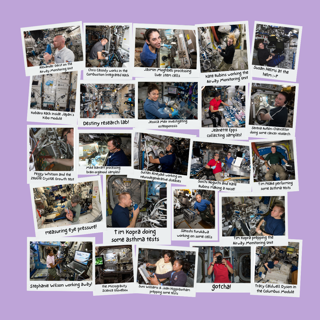
Thursday: Fundamental Research
You are tasked with conducting groundbreaking disease research that could transform lives back home. The ISS has provided revolutionary insight into asthma, heart disease, cancer, Parkinson’s disease, and Alzheimer’s disease.
In this microgravity environment, scientists have been able to study protein clusters linked to neurodegenerative diseases such as Alzheimer’s in entirely new ways. Astronauts investigating cancer have been able to examine the growth of endothelial cells which are crucial for blood supply and essential for tumour development. It has been discovered that these space-grown cells develop more efficiently in space than on Earth and so offer a powerful tool for testing and advancing cancer treatments.
Today you will be breathing to not only keep yourself alive, but also in the name of science, as you will continue the space station’s research into asthma. Asthma is a lung condition where airways become inflamed and narrowed, making it hard to breathe. Nitric oxide is a molecule that impacts asthma and contributes to inflammation. The Airway Monitoring experiment explores the amount of nitric oxide expelled by astronauts in microgravity. Using a specially designed mask, you will breathe at normal pressure and then head to the Quest airlock where astronauts usually venture outside for a spacewalk. Here, the pressure is reduced by 30%, or the equivalent to being at 3,000 metre altitude on Earth which is about the height of two Ben Nevis mountains stacked on top of each other.
These experiments aim to detect early signs of airway inflammation and allow intervention before it can develop into a serious health issue. Results from these studies on asthma are already helping to advance lung tests for an improved quality of life on Earth and in space – hospitals are now able to use an instrument that measures exhaled air for levels of nitric oxide to aid in diagnosing inflamed lungs and asthma. Future Moon and Mars explorers will also benefit from these tests – lungs may become irritated by dust particles. Gaining an insight into how weightlessness and reduced pressure can affect the health of your airways will equip space explorers to better monitor, diagnose, and treat lung inflammation.
The space station serves as a powerful tool to offer new perspectives in the fight against diseases that have impacted millions of people that generations have been working to combat and overcome. Research in space enables a clearer understanding of these diseases and their behaviours and can provide successful responses for diagnoses and treatments.
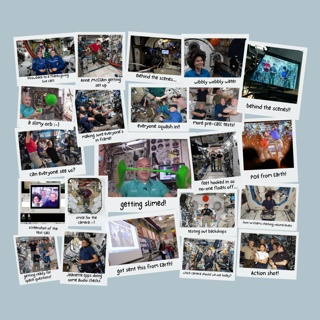
Friday: Live Conference
It's a big day - your face is about to beam all the way down to Earth! You need to look clean and sharp, but with no showers or running water onboard, you use wet wipes and no-rinse shampoo for that squeaky clean, space-approved glow. And when it’s time to keep your smile camera-ready, you brush as usual. Though there’s no sink to spit into, so you swallow the toothpaste. Minty freshness that defies gravity and prevents cavities!
You're scheduled to video call with a group of Year 5 children from a school in England. These outreach opportunities link students directly to astronauts to provide a unique and authentic experience designed to enhance their learning and overall interest in science, technology, engineering, and mathematics (STEM). This call will see you demonstrate the effects of microgravity on a non-Newtonian fluid in space: slime!
This experiment is a classic case of curiosity leading to discovery - what happens to slime in space? Over your experimentations, you find that the slime formed into floating blobs like water does, but the water globules are wobbly because of water’s lower viscosity (this is how fast or slow it flows), compared to the slime balls that stabilised into green orbs. When squashed between two paddles, the slime formed a gloopy bridge as the paddles were pulled apart, before snapping and springing back the surface of the paddles.
The experiments provide a clear demonstration of why slime is classified as a non-Newtonian fluid – simply put, this means the slime will break if it is pulled apart but will flow like honey if it is gently poured out of a jar. The information you have collected is not only fun for the students to observe but also provides researchers with data that can be applied to liquid containment in space, as well as investigating if non-Newtonian fluids could be used for watering plants and food crops in space.
You wrap up the video call with some questions that were sent in from the children, including questions about going to the toilet in space (you always get asked this one!), and what your favourite thing about being an astronaut is.
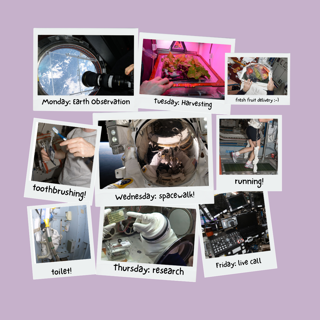
As your week aboard the ISS draws to a close, you float quietly in the stillness of orbit with the Earth turning gently beneath you. This was just one week in the diary of space exploration, but you think back to all that you’ve achieved. You've fixed power regulators, cultivated crops, explored the mysteries of human disease, floated in the infinite blackness of a spacewalk, and inspired the next generation with green blobs of floating slime. You've eaten vacuum-packed meals, worked your muscles against the will of microgravity, and gazed out at our fragile world glowing against the vastness of space.
But more than that, you’ve been a living part of humanity’s greatest adventure. Every sunrise you watched from the Cupola window, every experiment you conducted, every message you sent back to Earth was a step forward for all of humanity. The ISS isn’t just a scientific laboratory; it is a classroom, a garden, and a place for the greatest exploration.
And the truth is, you don’t have to wear a spacesuit to be a part of this journey. Wherever you are reading this, space is for everyone, and it belongs to all of us. It reminds us to stay curious, to reach higher, and to work together.
So the next time you look up at the night sky and catch a glimpse of a bright light racing across the stars, remember, that’s the International Space Station. And up there, someone might be brushing their teeth, fixing a power system, or gazing down on you on our beautiful blue planet: our home in this vast, dark universe.
Full Credits / References:
All images throughout this blog are NASA and are in the public domain.


